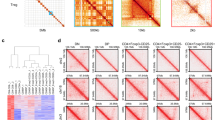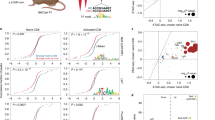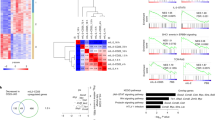Abstract
Type 1 regulatory T cells (Tr1 cells) are induced by interleukin-27 (IL-27) and have critical roles in the control of autoimmunity and resolution of inflammation. We found that the transcription factors IRF1 and BATF were induced early on after treatment with IL-27 and were required for the differentiation and function of Tr1 cells in vitro and in vivo. Epigenetic and transcriptional analyses revealed that both transcription factors influenced chromatin accessibility and expression of the genes required for Tr1 cell function. IRF1 and BATF deficiencies uniquely altered the chromatin landscape, suggesting that these factors serve a pioneering function during Tr1 cell differentiation.
This is a preview of subscription content, access via your institution
Access options
Access Nature and 54 other Nature Portfolio journals
Get Nature+, our best-value online-access subscription
$29.99 / 30 days
cancel any time
Subscribe to this journal
Receive 12 print issues and online access
$209.00 per year
only $17.42 per issue
Buy this article
- Purchase on Springer Link
- Instant access to full article PDF
Prices may be subject to local taxes which are calculated during checkout







Similar content being viewed by others
References
Roncarolo, M.G. et al. Interleukin-10-secreting type 1 regulatory T cells in rodents and humans. Immunol. Rev. 212, 28–50 (2006).
Pot, C., Apetoh, L. & Kuchroo, V.K. Type 1 regulatory T cells (Tr1) in autoimmunity. Semin. Immunol. 23, 202–208 (2011).
Astier, A.L., Meiffren, G., Freeman, S. & Hafler, D.A. Alterations in CD46-mediated Tr1 regulatory T cells in patients with multiple sclerosis. J. Clin. Invest. 116, 3252–3257 (2006).
Barrat, F.J. et al. In vitro generation of interleukin 10-producing regulatory CD4(+) T cells is induced by immunosuppressive drugs and inhibited by T helper type 1 (Th1)- and Th2-inducing cytokines. J. Exp. Med. 195, 603–616 (2002).
Awasthi, A. et al. A dominant function for interleukin 27 in generating interleukin-10-producing anti-inflammatory T cells. Nat. Immunol. 8, 1380–1389 (2007).
Fitzgerald, D.C. et al. Suppressive effect of IL-27 on encephalitogenic Th17 cells and the effector phase of experimental autoimmune encephalomyelitis. J. Immunol. 179, 3268–3275 (2007).
Wang, H. et al. IL-27 induces the differentiation of Tr1-like cells from human naive CD4+ T cells via the phosphorylation of STAT1 and STAT3. Immunol. Lett. 136, 21–28 (2011).
Batten, M. et al. Interleukin 27 limits autoimmune encephalomyelitis by suppressing the development of interleukin 17-producing T cells. Nat. Immunol. 7, 929–936 (2006).
Apetoh, L. et al. The aryl hydrocarbon receptor interacts with c-Maf to promote the differentiation of type 1 regulatory T cells induced by IL-27. Nat. Immunol. 11, 854–861 (2010).
Pot, C. et al. Cutting edge: IL-27 induces the transcription factor c-Maf, cytokine IL-21, and the costimulatory receptor ICOS that coordinately act together to promote differentiation of IL-10-producing Tr1 cells. J. Immunol. 183, 797–801 (2009).
Iwasaki, Y. et al. Egr-2 transcription factor is required for Blimp-1-mediated IL-10 production in IL-27-stimulated CD4+ T cells. Eur. J. Immunol. 43, 1063–1073 (2013).
Chang, J.T., Wherry, E.J. & Goldrath, A.W. Molecular regulation of effector and memory T cell differentiation. Nat. Immunol. 15, 1104–1115 (2014).
Josefowicz, S.Z. Regulators of chromatin state and transcription in CD4 T-cell polarization. Immunology 139, 299–308 (2013).
Tripathi, S.K. & Lahesmaa, R. Transcriptional and epigenetic regulation of T-helper lineage specification. Immunol. Rev. 261, 62–83 (2014).
Ciofani, M. et al. A validated regulatory network for Th17 cell specification. Cell 151, 289–303 (2012).
Kurachi, M. et al. The transcription factor BATF operates as an essential differentiation checkpoint in early effector CD8+ T cells. Nat. Immunol. 15, 373–383 (2014).
Owaki, T. et al. A role for IL-27 in early regulation of Th1 differentiation. J. Immunol. 175, 2191–2200 (2005).
Pot, C., Apetoh, L., Awasthi, A. & Kuchroo, V.K. Induction of regulatory Tr1 cells and inhibition of T(H)17 cells by IL-27. Semin. Immunol. 23, 438–445 (2011).
Bettelli, E. et al. Myelin oligodendrocyte glycoprotein-specific T cell receptor transgenic mice develop spontaneous autoimmune optic neuritis. J. Exp. Med. 197, 1073–1081 (2003).
Schraml, B.U. et al. The AP-1 transcription factor Batf controls T(H)17 differentiation. Nature 460, 405–409 (2009).
Im, S.H., Hueber, A., Monticelli, S., Kang, K.H. & Rao, A. Chromatin-level regulation of the IL10 gene in T cells. J. Biol. Chem. 279, 46818–46825 (2004).
Jones, E.A. & Flavell, R.A. Distal enhancer elements transcribe intergenic RNA in the IL-10 family gene cluster. J. Immunol. 175, 7437–7446 (2005).
Mosser, D.M. & Zhang, X. Interleukin-10: new perspectives on an old cytokine. Immunol. Rev. 226, 205–218 (2008).
Sjöstrand, M. et al. Expression of the immune regulator tripartite-motif 21 is controlled by IFN regulatory factors. J. Immunol. 191, 3753–3763 (2013).
Yoshida, K. et al. Active repression of IFN regulatory factor-1-mediated transactivation by IFN regulatory factor-4. Int. Immunol. 17, 1463–1471 (2005).
Ise, W. et al. The transcription factor BATF controls the global regulators of class-switch recombination in both B cells and T cells. Nat. Immunol. 12, 536–543 (2011).
Hirahara, K. et al. Asymmetric action of STAT transcription factors drives transcriptional outputs and cytokine specificity. Immunity 42, 877–889 (2015).
Li, P. et al. BATF-JUN is critical for IRF4-mediated transcription in T cells. Nature 490, 543–546 (2012).
Glasmacher, E. et al. A genomic regulatory element that directs assembly and function of immune-specific AP-1-IRF complexes. Science 338, 975–980 (2012).
Eason, D.D., Shepherd, A.T. & Blanck, G. Interferon regulatory factor 1 tryptophan 11 to arginine point mutation abolishes DNA binding. Biochim. Biophys. Acta 1446, 140–144 (1999).
Lee, C.G. et al. A distal cis-regulatory element, CNS-9, controls NFAT1 and IRF4-mediated IL-10 gene activation in T helper cells. Mol. Immunol. 46, 613–621 (2009).
Buenrostro, J.D., Giresi, P.G., Zaba, L.C., Chang, H.Y. & Greenleaf, W.J. Transposition of native chromatin for fast and sensitive epigenomic profiling of open chromatin, DNA-binding proteins and nucleosome position. Nat. Methods 10, 1213–1218 (2013).
Langmead, B. & Salzberg, S.L. Fast gapped-read alignment with Bowtie 2. Nat. Methods 9, 357–359 (2012).
McCarthy, M.T. & O'Callaghan, C.A. PeaKDEck: a kernel density estimator-based peak calling program for DNaseI-seq data. Bioinformatics 30, 1302–1304 (2014).
Quinlan, A.R. & Hall, I.M. BEDTools: a flexible suite of utilities for comparing genomic features. Bioinformatics 26, 841–842 (2010).
Anders, S., Pyl, P.T. & Huber, W. HTSeq—a Python framework to work with high-throughput sequencing data. Bioinformatics 31, 166–169 (2015).
Love, M.I., Huber, W. & Anders, S. Moderated estimation of fold change and dispersion for RNA-seq data with DESeq2. Genome Biol. 15, 550 (2014).
Shishkin, A.A. et al. Simultaneous generation of many RNA-seq libraries in a single reaction. Nat. Methods 12, 323–325 (2015).
Dobin, A. et al. STAR: ultrafast universal RNA-seq aligner. Bioinformatics 29, 15–21 (2013).
Kheradpour, P. & Kellis, M. Systematic discovery and characterization of regulatory motifs in ENCODE TF binding experiments. Nucleic Acids Res. 42, 2976–2987 (2014).
Weirauch, M.T. et al. Determination and inference of eukaryotic transcription factor sequence specificity. Cell 158, 1431–1443 (2014).
Grant, C.E., Bailey, T.L. & Noble, W.S. FIMO: scanning for occurrences of a given motif. Bioinformatics 27, 1017–1018 (2011).
Wingender, E., Schoeps, T. & Dönitz, J. TFClass: an expandable hierarchical classification of human transcription factors. Nucleic Acids Res. 41, D165–D170 (2013).
Blatti, C., Kazemian, M., Wolfe, S., Brodsky, M. & Sinha, S. Integrating motif, DNA accessibility and gene expression data to build regulatory maps in an organism. Nucleic Acids Res. 43, 3998–4012 (2015).
Watters, A.M., Miraldi, E.R., Martins de Castro, D., Pokrovskii, M. & Bonneau, R. A fast-adapting, scriptable framework for gene regulatory network visualization. Submitted.
Pérez, F.G.B.E. IPython: A System for Interactive Scientific Computing. Comput. Sci. Eng. 9, 21–29 (2007).
Csardi, G. & Nepusz, T. The igraph software package for complex network research. InterJournal, Complex Systems 1695 (2006).
Oliphant, T.E. Python for scientific computing. Comput. Sci. Eng. 9, 10–20 (2007).
Acknowledgements
We thank D. Kozoriz (Evergrande Center) for cell sorting, F. Quintana (Harvard Medical School) for providing AhR mutant mice, the New York University Langone Medical Center genomics core (A. Heguy and P. Zappile) for help with sequencing, and the Genome Technology Center (at the Laura and Isaac Perlmutter Cancer Center supported by the Cancer Center Support Grant P30CA016087) for help with sequencing. We are most thankful to M. Collins for advice and editing of the manuscript. This work was supported by the US national Institutes of Health (R01 NS 030843, R01 NS 045937, P01 AI073748, P01 NS076410, P01 AI039671 and 5P01 AI056299-10 to V.K.K.; P01NS076410 to D.L. and M.P.; 5T32AI100853 to M.P.; 1R01-DK103358-01 to E.R.M., R.B. and D.L.; and 1R01-GM112192-01 to R.B.), the National Multiple Sclerosis Society (K.K.), Marie Skłodowska-Curie Actions (of the European Commission / Research Executive Agency), grant agreement number 302915, Marie Curie International Outgoing Fellowship (K.K.), the National Science Foundation (IOS-1126971 to R.B.), the DBT-Wellcome Trust (IA/I/12/1/500524 to A.A.), the Klarman Cell Observatory at the Broad Institute (A.R.), the Howard Hughes Medical Institute (A.R.) and the National Cancer Institute (Koch Institute Support (P30-CA14051 to A.R.).
Author information
Authors and Affiliations
Contributions
K.K. planned, performed and analyzed all of the biological experiments and wrote the manuscript. E.R.M. designed and actuated computational analyses for RNA-seq/ATAC-seq, and contributed to the interpretation of the results and writing of the manuscript. M.P. prepared ATAC-seq libraries, coordinated sequencing with the NYUMC genomics core, and contributed to interpretation of the results and general discussion. A.M., N.Y., X.C., A.W. and N.C. contributed to computational analysis. I.W. prepared RNA-seq libraries and coordinated sequencing. A.A. provided reagents and advice. A.R. developed and undertook transcriptional analysis of IL-27-induced Tr1 cells. R.B. contributed to computational analysis, interpretation of the results and writing of the manuscript. D.L. advised and provided insight into the analysis of ATAC-seq and RNA-seq analysis. V.K.K. supervised the study and wrote the manuscript.
Corresponding author
Ethics declarations
Competing interests
The authors declare no competing financial interests.
Integrated supplementary information
Supplementary Figure 1 IRF1 and BATF affect T cell gene expression in vitro and in vivo
(a) Quantification of IL-10 and IFN-γ expression in WT, Irf1-/- and Batf-/- naïve cells differentiated in Tr1 conditions for 72 hrs. Dots represent individual mice. (b) FoxP3 expression (mRNA) in WT and Irf1−/− cells treated with TGF-β1 for 72 hrs. (c) Il10 expression in TH0 CD4+ T cells transduced with a retroviral vector expressing IRF1 and/or BATF. (d) Heatmap showing differential gene expression in cells isolated from WT, Irf1−/− and Batf−/− mice immunized with MOG35-55 and restimulated in vitro in the presence of MOG35-55 and IL-23. (e) IL-17A expression measured by FACS in WT and Irf1−/− cells differentiated in vitro in Th17 polarizing conditions (IL-1β+IL-6+IL-23). (f) Quantification of the frequency of IL-17A+ cells shown in (e). (g) Comparison of gene expression in CD4+ T cells differentiated in vitro with IL-27 and CD4+ T cells isolated from mice immunized with MOG35-55 and later restimulated in the presence of IL-27. Shown are fold changes between cells treated with IL-27 and cells treated in the absence of IL-27. Data are pooled from 3 independent experiments (a, b, c), representative of three independent experiments (e, f), pooled from 2 independent experiments (d, g). NS, not significant (P > 0.05); *P < 0.05, **P < 0.001 and ***P < 0.0001 (unpaired t-test, error bars represent mean ±s.e.m.).
Supplementary Figure 2 IRF1 and IRF4 play opposite roles during Tr1 and Th17 differentiation
(a) FACS analysis of IL-10 expression in WT and Irf4−/− cells differentiated in Th0 and Tr1 conditions for 72 hours. (b) Il17a expression (mRNA) in CD4+ T cells differentiated in Th17 polarizing conditions (IL-1β+IL-6+IL-23) with either IRF1 (right bar) or a GFP control (middle bar) retrovirally transduced (c) IL-17A luciferase reporter activity in 293T cells expressing IRF1, IRF4 or both. (d) Il10 expression (mRNA) in CD4+ T cells differentiated in Tr1 polarizing conditions with either IRF4 (right bar) or a GFP control (middle bar) retrovirally transduced. (e) IL-10 luciferase reporter (proximal promoter, HSS+2.98 and CNS-9 fragments) activity in 293T cells expressing IRF1, IRF4 or both. (f) IRF1 binding to sites within Il17a, Il23r and Rorc in WT, Irf1−/− and Irf4−/− CD4+ T cells differentiated in Th17 polarization conditions (IL-1β+IL-6+IL-23). Relative mean enrichment fold (±s.e.m.) in reference to a control antibody is presented. Data are representative of 3 independent experiments (a, c, e), 2 independent experiments (b, d) or pooled from 2 independent experiments (f).
Supplementary Figure 3 Differential accessibility analysis (ATAC-seq)
(a) Number of differentially accessible peaks detected using DESeq2, for many comparisons of interest (log2|FC|>1, FDR=10%). (b) PCA of all ATAC-seq samples, using all ATAC-seq peaks in the dataset (180,478 peaks, log10-transformed intensities).
Supplementary Figure 4 BATF- and IRF1-deficiencies alter Tr1 gene expression patterns
(a) PCA of RNA-seq gene expression data for Irf1−/−, Batf−/− and control Tr1 cells at 72h (15,715 genes, log2-noramlized relative to mean). The PCA scores plot, with samples plotted as functions of gene expression (black (WT), red (Irf1−/−), blue (Batf−/−) balls), is super-imposed on the loadings plot (showing the top 50 genes whose patterns contribute most to the dominant gene expression trends in the dataset). (b) The number of differentially expressed genes, comparing KO to control (FDR=10%, log2|fold-change|>1). (c) The most dramatically KO-dependent genes (FDR=1%, log2|fold-change|>2, for either Batf−/− or Irf1−/−, relative to control).
Supplementary Figure 5 Tr1 IRF1-dependent Network (Zoom-in)
RNA-seq and ATAC-seq datasets were integrated to generate putative transcriptional regulatory networks for Irf1−/− Tr1 cells. Nodes represent differentially expressed transcription factors and target genes, colored according to relative gene expression (log2(Irf1−/−/Control)) at 72h; red and blue indicate high and low relative expression, respectively. Edges are drawn between differentially expressed TFs and putative gene targets if that TF’s motif was enriched in ATAC-seq peaks cis to genes that were increased or decreased in response to Irf1−/− (Praw<10-3, hypergeometric CDF). Edge colors (blue - inhibitory, red - activating) are based on correlation between TF and putative target gene expression. “ON” indicates genes de-repressed in the knockout cells, while “OFF” indicates genes repressed in the knockout cells.
Supplementary Figure 6 Tr1 BATF-dependent Network (Zoom-in)
RNA-seq and ATAC-seq datasets were integrated to generate putative transcriptional regulatory networks for Batf−/− Tr1 cells. Nodes represent differentially expressed transcription factors and target genes, colored according to relative gene expression (log2(Batf−/−/Control)) at 72h; red and blue indicate high and low relative expression, respectively. Edges are drawn between differentially expressed TFs and putative gene targets if that TF’s motif was enriched in ATAC-seq peaks cis to genes that were increased or decreased in response to Batf−/− (Praw<10-3, hypergeometric CDF). Edge colors (blue - inhibitory, red - activating) are based on correlation between TF and putative target gene expression. “ON” indicates genes de-repressed in the knockout cells, while “OFF” indicates genes repressed in the knockout cells.
Supplementary information
Supplementary Text and Figures
Supplementary Figures 1–6 and Supplementary Table 1 (PDF 1307 kb)
Rights and permissions
About this article
Cite this article
Karwacz, K., Miraldi, E., Pokrovskii, M. et al. Critical role of IRF1 and BATF in forming chromatin landscape during type 1 regulatory cell differentiation. Nat Immunol 18, 412–421 (2017). https://doi.org/10.1038/ni.3683
Received:
Accepted:
Published:
Issue Date:
DOI: https://doi.org/10.1038/ni.3683
This article is cited by
-
Selective targeting or reprogramming of intra-tumoral Tregs
Medical Oncology (2024)
-
Functional dissection of inherited non-coding variation influencing multiple myeloma risk
Nature Communications (2022)
-
CAR directs T cell adaptation to bile acids in the small intestine
Nature (2021)
-
Chromatin information content landscapes inform transcription factor and DNA interactions
Nature Communications (2021)
-
From reads to insight: a hitchhiker’s guide to ATAC-seq data analysis
Genome Biology (2020)



